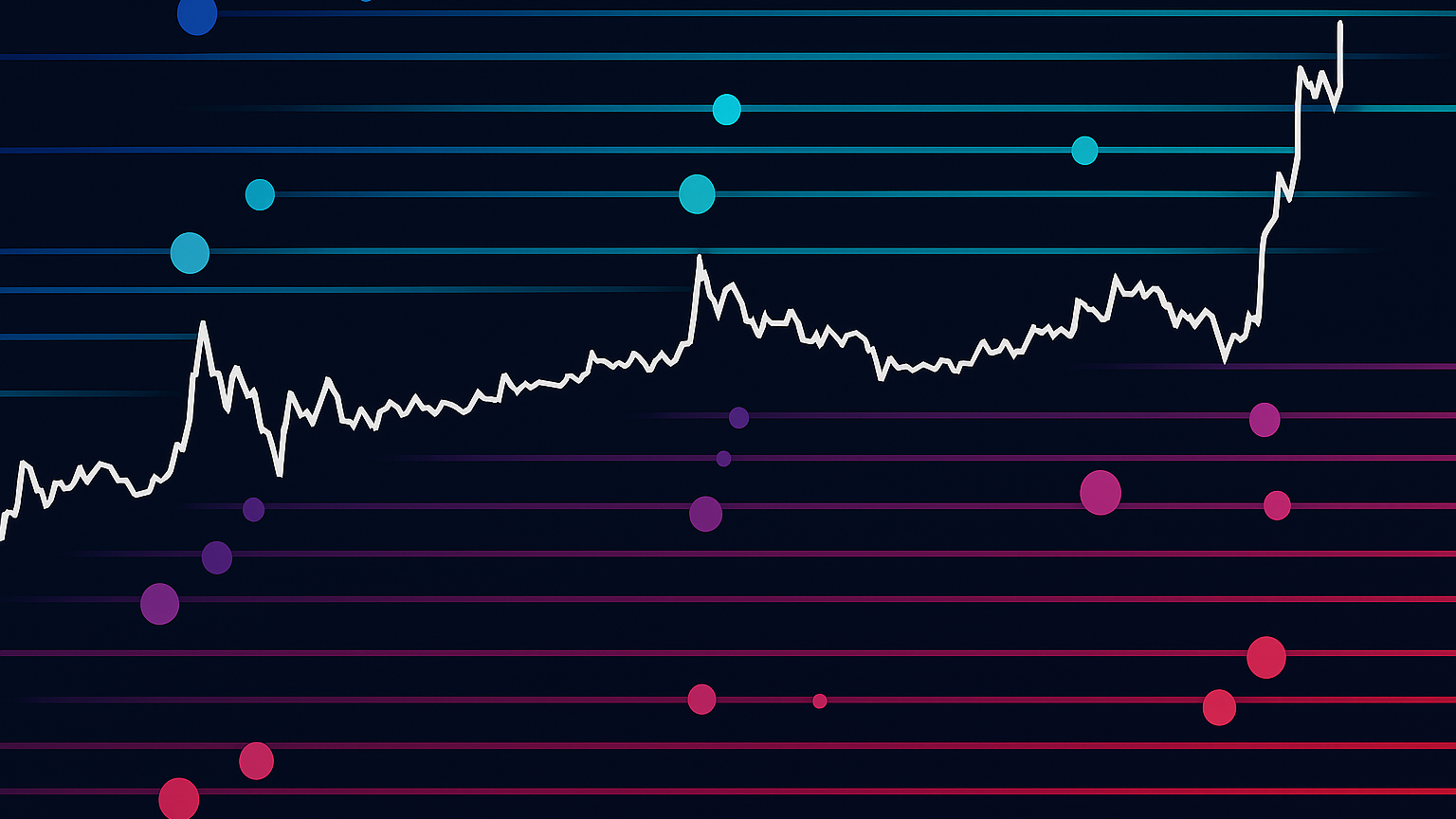Learn about key bearish chart patterns like head and shoulders, descending triangles, and double tops to anticipate market price drops effectively.
Bearish chart patterns help traders predict price drops in markets by analyzing shapes on price charts. These patterns, like head and shoulders, descending triangles, and double tops, are widely used for spotting bearish trends. Here's why they matter and how they work:
- Head and Shoulders: Signals bearish reversals with 93% accuracy when confirmed. Entry occurs after the price breaks below the neckline with volume.
- Descending Triangle: Indicates trend continuation with a 64% success rate when price breaks horizontal support.
- Double Top: Effective in trending markets, with a 72% success rate, confirmed by a break below the neckline.
Key Confirmation Techniques:
- Use volume analysis (e.g., spikes during breakouts) to validate patterns.
- Combine with indicators like RSI and MACD for stronger signals.
- Manage risk with stop-loss orders above resistance levels and proper position sizing.
These techniques provide clear entry points and help control risk. Backtest and refine strategies for consistent results.
Head And Shoulders Pattern Trading Course
Common Bearish Patterns
Certain chart patterns can signal potential market reversals or downward price movements. Here, we’ll break down three patterns that traders often rely on for spotting bearish trends.
Head and Shoulders Pattern
This well-known reversal pattern shows up in various markets, especially forex. It’s made up of three peaks: the left shoulder, the higher head, and the right shoulder, which is typically similar in height to the left. The neckline, a line connecting the troughs between these peaks, acts as a key support level. A pattern is confirmed when the price breaks below the neckline with increasing volume. On average, the price drop after confirmation is about 62% of the pattern’s height [7].
Descending Triangle Pattern
This pattern often signals a continuation of a bearish trend, aligning with the weakening momentum discussed earlier. It has a 64% success rate in predicting downward breakouts [1].
Key features include:
- A horizontal support level paired with descending resistance
- Volume contraction as the pattern forms
- A valid breakout occurs when the price closes below the support level
Double Top Pattern
The double top pattern, like the head and shoulders, depends on a break below the neckline for confirmation. It forms when the price tests a resistance level twice but fails to break through, signaling reduced buying pressure. This pattern is particularly effective in trending markets, with a 72% success rate [3].
| Phase | Description | Volume Behavior |
|---|---|---|
| First Peak | Tests resistance level | High volume |
| Valley | Pulls back from resistance | Declining volume |
| Second Peak | Fails to break resistance | Lower volume than first peak |
| Breakdown | Falls below valley support | Sharp volume increase |
These patterns gain more reliability when paired with additional confirmation techniques, which we’ll cover in the next section.
Pattern Confirmation and Risk Control
Validating bearish patterns and managing risk are key components of successful trading. Here’s a breakdown of practical methods to confirm patterns and safeguard your investment.
Volume Analysis
Volume plays a critical role in confirming patterns. Look for these key signals:
- Gradual increases during the pattern's formation, indicating building pressure.
- Breakout moments with volume spikes exceeding 50%.
- Sustained high volume after the breakout, confirming continued momentum.
The On-Balance Volume (OBV) indicator is especially useful. A declining OBV during the pattern formation and sharp drops during a breakout signal strong selling momentum. These behaviors align with patterns like head and shoulders or double tops, making volume analysis a reliable tool for confirmation.
Stop-Loss Placement
Placing stop-loss orders correctly is essential for managing risk. Here’s how to position stops based on specific patterns:
- Head and shoulders: Set the stop above the right shoulder.
- Descending triangles: Place it above the most recent lower high.
For a more refined approach, use stops adjusted for volatility – 2 to 3 times the Average True Range (ATR) above entry points. Combining this strategy with timeframe analysis enhances risk control. Keep your risk per trade within 1-2% of your total capital, a widely recommended guideline among professional traders.
Professional Trading Techniques
Professional traders refine their bearish pattern analysis by combining multiple timeframes with technical indicators. These advanced methods build on earlier confirmation techniques, helping traders make more precise decisions.
Timeframe Analysis Methods
A top-down approach is a common strategy among professional traders:
| Timeframe | Purpose | Focus |
|---|---|---|
| Daily | Identify trend direction | Assess overall market structure and key support/resistance levels |
| 4-Hour | Observe pattern formation | Track bearish patterns and breakout zones |
| 1-Hour | Pinpoint entry timing | Determine exact entry points and set initial stop levels |
When working across different timeframes, alignment is key. For example, a bearish head and shoulders pattern that aligns across multiple timeframes is typically more reliable.
Pattern and Indicator Combinations
Pairing patterns with technical indicators can strengthen your analysis and increase confidence in your trades.
- RSI (Relative Strength Index): Look for RSI readings above 70 at critical points, such as the "head" of a head and shoulders pattern or the second peak of a double top.
- MACD (Moving Average Convergence Divergence): Watch for MACD crossovers when price breaks through support, signaling downward momentum.
Here are two practical strategies to enhance your trading:
- Indicator Divergence: Pay attention to bearish divergence between price action and indicators during the final stages of a pattern.
- Pattern Quality: Prioritize patterns that meet strong technical criteria for confirmation.
Patience and discipline are essential for successful pattern trading. Stick to your strategy and wait for clear setups.
Summary and Next Steps
Now that we've covered bearish chart patterns, it's time to apply what you've learned. These strategies rely on the confirmation methods and risk management principles discussed earlier. To succeed, you'll need a structured approach that combines technical analysis with disciplined decision-making.
Action Plan for Bearish Pattern Strategies
| Phase | Key Actions | Success Metrics |
|---|---|---|
| Pattern Recognition | Analyze chart patterns systematically | 90% accuracy in live market identification |
| Confirmation Setup | Use volume analysis, indicators, and timeframes | Clear confirmation signals present |
| Risk Control | Set position sizes (1-2% per trade) and stop-loss | Achieve 1:2 risk-reward ratio per trade |
Getting Started with Pattern Trading
Start by backtesting historical data for the patterns you've learned. Focus on mastering one pattern at a time until you see consistent results [2][7]. This step is crucial for building confidence and refining your approach.
Strengthening Your Signals
Pair your pattern analysis with technical indicators to improve accuracy. This approach helps confirm potential market reversals and makes your trades more reliable [2][4].
Risk Management Basics
Protect your capital by sticking to strict risk controls. Use stop-loss orders placed above key resistance levels and consider trailing stops to lock in profits as your trades progress [5].
Steps for Professional Growth
- Develop a trading plan tailored to specific patterns.
- Backtest your strategies using historical charts.
- Track performance metrics in a trading journal.
- Review and adjust your strategies weekly.
Patience and discipline are essential for success. Focus on high-quality setups rather than chasing every opportunity.
Considering Market Context
Bearish patterns work best when analyzed within the larger market environment. Pay attention to broader trends and critical price levels, as these factors greatly influence the effectiveness of your trades [7].
FAQs
Here are answers to common questions traders have about using bearish patterns:
How do you trade using a double top pattern?
Trading a double top pattern involves three main steps:
- Identify the pattern: Look for two similar peaks with a valley in between acting as support.
- Entry point: Enter the trade when the price breaks below the neckline.
- Set targets: Aim for a price move equal to the height of the pattern.
Is the double top pattern effective?
The double top pattern can be very effective when confirmed with additional signals. As noted earlier, its success improves when combined with:
- Volume confirmation: Ensure there’s strong volume during the breakdown.
- Indicators: Use tools like RSI or MACD for alignment.
- Resistance clarity: Watch for clear price action at resistance levels.
What’s the trading approach for a head and shoulders pattern?
To trade a head and shoulders pattern, follow these steps:
- Entry: Enter the trade when the price breaks below the neckline with strong volume.
- Stop-loss: Place your stop-loss just above the right shoulder.
- Target: Aim for a price move equal to the distance between the head and the neckline.
How can you spot a head and shoulders pattern early?
While predicting a head and shoulders pattern isn’t precise, you can watch for these signs:
- Left shoulder: An initial peak forms with strong volume.
- Head: A higher peak follows, but with lower volume.
- Right shoulder: A lower peak forms, with volume continuing to decline.
Pay close attention to the declining volume during the right shoulder’s formation compared to the head. This is a key confirmation signal, reinforcing the volume and indicator techniques discussed earlier, and aligns with the risk management strategies outlined in this guide [3][6].
References
- LuxAlgo Double Tops
- LuxAlgo Reversal Spotting
- RSI - Investopedia
- MACD - Wikipedia
- Head and Shoulders Pattern - Investopedia
- Bearish Chart Patterns - Strike Money
- Bearish Chart Patterns - GetTogetherFinance
- Bearish Chart Patterns - TrendSpider
- Head and Shoulders - Personal Finance Lab
- Market Structure - LuxAlgo
- LuxAlgo Support & Resistance
- LuxAlgo Valid Breakout Indicator







